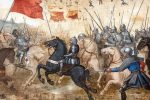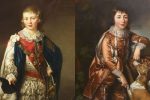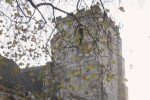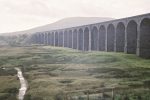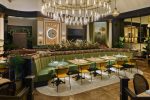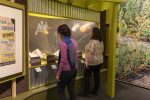The Vikings in Yorkshire
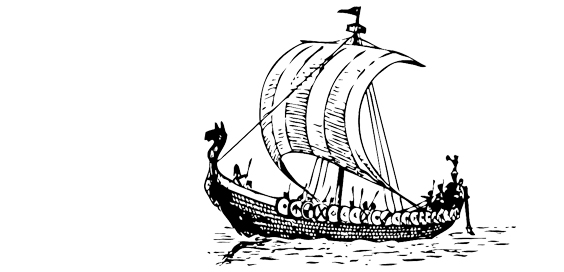
By Ingrid Barton
The destruction of Lindisfarne was the first of regular Viking raids that eventually turned into invasion. The word ‘Viking’ really means ‘raider’. A Viking was a man (though there is some evidence that there were women as well) who left his own homeland to gain fame and fortune in someone else’s. During this period increasing population growth in Scandinavia meant that acquiring land – the only way to become an important person – was becoming more and more difficult. The swiftest way for young men to make a name for themselves was to join together and take their chances across the seas in raiding ventures. Vikings came from Norway as well as Denmark. They were quite capable of raiding each other.
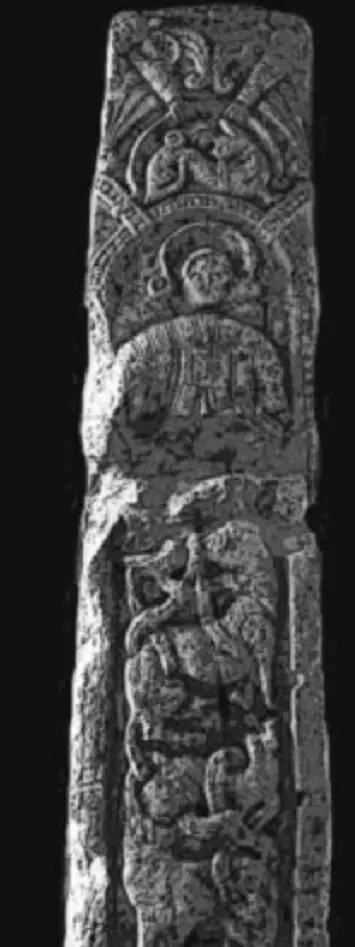 Tales of the incredible wealth and gold of English monasteries had spread to Scandinavia, but, like the Anglo-Saxons before them, men wanted land as well as the rich plunder, preferably land with captured slaves to work it. There were many other raids along the Northumbrian coast in the years following 793, but in 865 a more serious threat arose. A ‘Great Heathen Army’ of Danes sailed from the Low Countries to East Anglia. They were led by the splendidly named Ivarr the Boneless and his brothers Halfdan and Ubba, already war-hardened veterans of campaigns in Europe. In the following year they sailed up the Humber and headed towards York.
Tales of the incredible wealth and gold of English monasteries had spread to Scandinavia, but, like the Anglo-Saxons before them, men wanted land as well as the rich plunder, preferably land with captured slaves to work it. There were many other raids along the Northumbrian coast in the years following 793, but in 865 a more serious threat arose. A ‘Great Heathen Army’ of Danes sailed from the Low Countries to East Anglia. They were led by the splendidly named Ivarr the Boneless and his brothers Halfdan and Ubba, already war-hardened veterans of campaigns in Europe. In the following year they sailed up the Humber and headed towards York.
“Biggest threat”
The Kingdom of Northumbria was, as usual, occupied with fighting between rival claimants for the throne. The rivals in this instance were Aelle and Osberht. Taken by surprise by the huge army of invaders, they forgot their grievances and joined forces, but too late: both were killed in the subsequent fighting. Ivarr is supposed to have had the Blood Eagle cut on Aelle (a ritualised method of execution) in revenge for his having killed Ivarr’s father, Ragnar Hairybreeches, in a pit of snakes, but this is, let us hope, probably just legend.
In 876 Halfdan shared out Northumbria between his followers and, as the Anglo-Saxon Chronicle records, ‘they proceeded to plough and support themselves.’ Bernicia, the northern half of Northumbria, doesn’t seem to have interested the Vikings as much as the richer southern half, Deira. With its capital at Yorvik (the latest version of York’s name) Deira became the Danish Kingdom of York and, ultimately, Yorkshire.
It was not, of course, the only part of Britain conquered by the Danes. King Alfred of Wessex halted their southern progress at the Battle of Edington in 878 and forced the leader of the southern Danish army to sign a treaty that established the limit of Danish conquests. They were to keep York, Nottingham, Derby, Lincoln and all the eastern counties above London. In those places the law of the Danes, rather than that of the Anglo-Saxons, was to run and so the area became known as the Danelaw. The Danes in England remained the biggest threat to Anglo-Saxon kings, siding with their enemies at home and in Scandinavia, inviting invasion from outside. One king, Aethelred, even tried genocide to get rid of them (though not in Yorkshire), but in vain.
“Many words in our language are Scandinavian in origin”
In the early years of the invasion those sources of literacy, monasteries, were widely destroyed. As their surviving monks were occupied with more urgent things than writing accounts about the invaders, once again we do not have a lot of information about the number of new settlers.
People didn’t distinguish between raiders from Denmark and raiders from Norway or elsewhere; they were all just Danes. Many Yorkshire villages have the Danish suffix –by or –thorpe, and about a third of place names in the East and North Ridings in Domesday Book are of Scandinavian origin, which suggests that local people must, at the very least, have been widely influenced by Scandinavian languages.
Many words in our language are Scandinavian in origin, Norse (Norwegian) as well as Danish. (West Yorkshire in particular, was influenced by Norwegians from the Viking kingdom of Dublin who began to farm land in and around the Pennines that hadn’t previously been used.) Yorkshire people still use ‘beck’ instead of ‘stream’ and ‘bairns’ for children. York streets are called ‘gates’ just as they are in Norway and there are a number of Scandinavian words in Yorkshire dialect for types of land: ‘carr’ (marsh); ‘slack’ (valley); ‘gill’ (ravine); and ‘holm’ (island).
Once they had established their kingdom, the Danish rulers of our area divided Yorkshire and its neighbouring Linsey in to three administrative parts called ‘thridings’ (thirdings) from which we get the Yorkshire Ridings. These were further divided into wapentakes (from the showing of weapons at assemblies). The invaders then converted to Christianity (possibly to impress the locals) and settled down to trade, Vikings no longer.
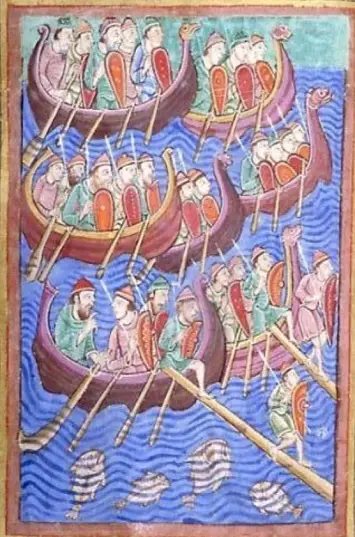
Danes in boats depicted invading England – note the lack of spiked helmets. From the 12th century ‘Miscellany on the Life of St. Edmund’
“A way of life that strongly contrasts with the image of the bloodthirsty pillager”
Little remains above ground to show they were here. None of their churches survive, though many were built by people keen to acquire status in their new kingdom, but a number of carved Viking stones and ‘hogback’ tombs can still be found. A few crosses remain, such as the famous Nunburnholme Cross, which include pagan as well as Christian imagery.
Our knowledge of Viking life has been enormously enhanced by the extensive York excavations of 1976–81. The oxygen-free environment of the site at Coppergate led to the preservation of a huge range of materials such as leather, cloth and wood, as well as timber buildings and the debris of domestic and manufacturing life. The Jorvik Viking Centre was opened to the public in 1984 and is the most important museum of Viking life in the country. It reveals a way of life that strongly contrasts with the image of the bloodthirsty pillager. Jorvik, it seems, was a busy manufacturing and trading centre, with a flourishing river trade up and down the Ouse, importing high-quality goods such as pottery and silk from all over Europe.
Its well-nourished citizens (only about 8cm shorter than us) were clean and well-dressed – Danes were famously natty dressers, with a taste for bright colours – possessing a wide range of combs, ear-scoops, tweezers, nail cleaners and toothpicks. The men did not – repeat, did not – ever wear horned helmets but they did appreciate a good sword as a sign of wealth and status. The women favoured the strange objects called tortoise brooches which were worn in pairs on the breast with a string of beads between. It was during the Viking period that the present layout of York streets was created.
“Bad times”
Control of York and the rest of Northumbria passed through many different hands over time, including those of the Norwegian Vikings from Dublin, but its last king, Eric Bloodaxe, was killed in 954 and it was then incorporated into what was fast becoming the Kingdom of England. This seems to have had little effect on Jorvik, however, and life went on much the same for the people of our county for 100 years.
But bad times were coming …
Yorkshire Folk:
Guthfrith, According to Symeon of Durham’s History of the Church of Durham Guthfrith, a Christian Viking was appointed King of York in 878 after St Cuthbert appeared in a dream to Abbot Eadred of Carlisle, telling him to find a lad named Guthfrith. This boy, said the Saint, had been sold to a widow. The Abbot must find him and pay the widow the price of his freedom and then present him to the army, telling them that it was the Saint’s wish he be made king. “Let the bracelet [of kingship] be placed on his right arm!” said the Saint. Eadred did as he was commanded but Guthfrith ruled only for a few years before dying and being buried in York Minster.
Places to Visit:
The Jorvik Centre: York
The Nunburnholme Cross: in St James’ Church at Nunburnholme near Pocklington
Collection of Viking age carved stones: St Wilfred’s Church, Burnsall. The church is on east side of the B6160 at the north end of Burnsall village
Article taken from ‘The Little history of Yorkshire’ by Ingrid Barton, published by The History Press, £12 hardback, ISBN: 9780750983563
